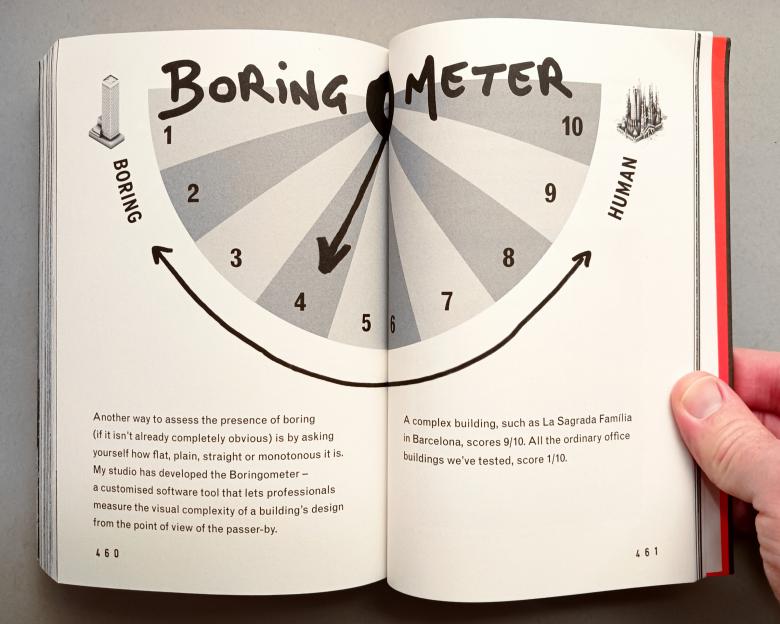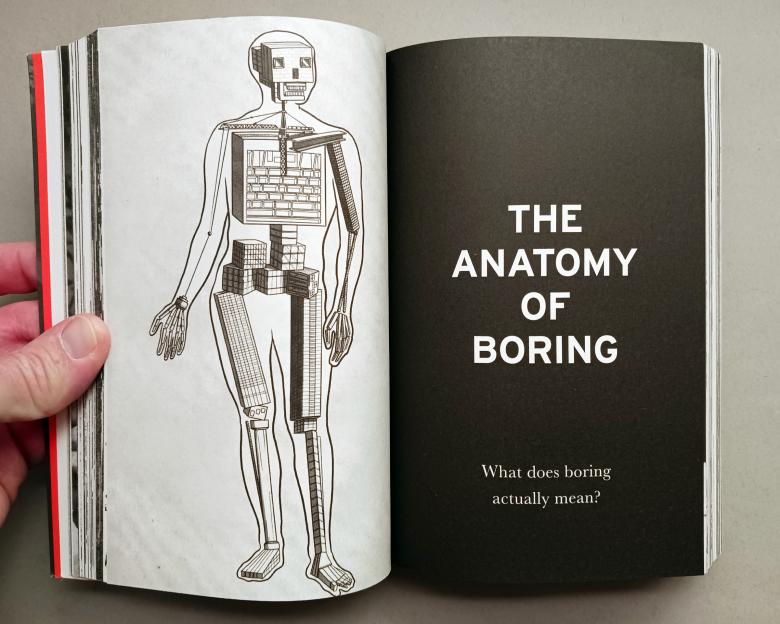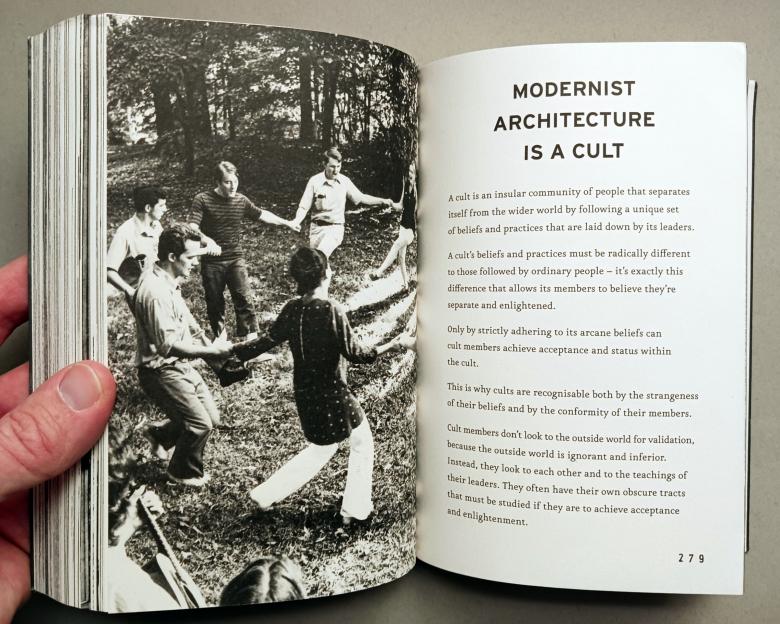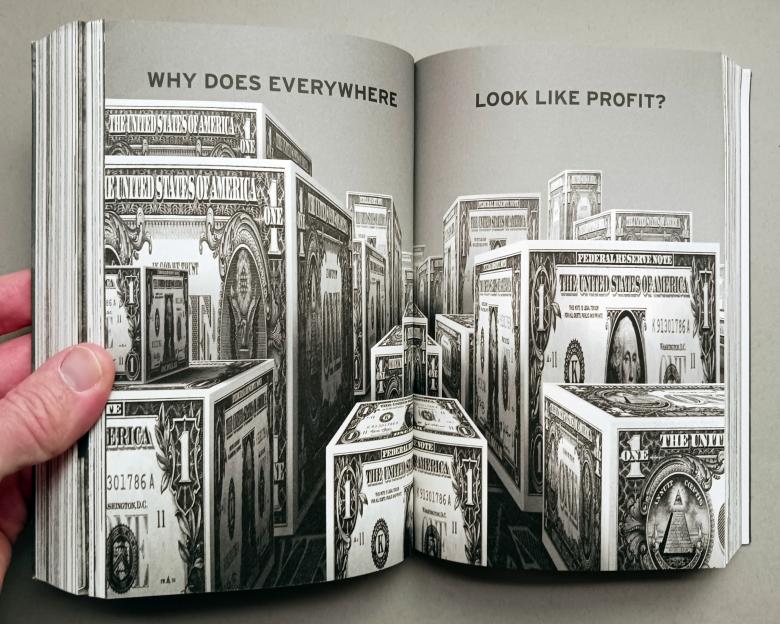Thomas Heatherwick's 'Humanise: A Maker's Guide to Building our World'
The Anatomy of 'Humanise'
John Hill
15. November 2023
The reviewer holding Humanise, in which Thomas Heatherwick holds Rainer Zaberst's monograph on Antoni Gaudí. (All photographs by John Hill/World-Architects)
On October 19, Penguin released Thomas Heatherwick's Humanise: A Maker's Guide to Building our World, billing it as “a story about humanity told through the lens of our buildings.” The book, a website, and other components under the Humanise name also comprise a manifesto — one that rails against boring buildings and advocates for the creation of interesting, human buildings. World-Architects dove into this widely discussed book.
A couple of decades ago, when I was working toward licensure while employed at an architecture firm in Chicago, I was drawing an elevation for a presentation the following day when the design partner stopped by my desk, looked over my shoulder, and said, “Needs more lines.” It didn’t matter if those lines were brick mortar joints, reveals in precast panels, or shadow lines below window sills, the more lines on a drawing, the better — the better it would look and the better chance the design would have of being approved. At the time I was annoyed, not because it created more work for me to do late at night, but because it felt dishonest; adding more lines did not mean it was an accurate expression of what was being proposed. I can’t remember if the extra lines resulted in extra detail on the building in the end, but the “needs more lines” comment stayed with me somewhere deep in the recesses of my brain. Then it jumped to the fore while reading Thomas Heatherwick’s new manifesto arguing against “boring” architecture and for “interesting” and “human” buildings.
Humanise proposes solutions, among them the “Boringometer,” a software tool developed by his studio.
If my younger self were magically transported to the London studio of designer Thomas Heatherwick today, I would be prompted to use the “Boringometer” to determine what shades of boring were present in my design. Instead of a two-dimensional CAD-drawn elevation made up of lines and more lines, a 3-D computer model would be fed into the studio’s own Boringometer software to precisely calculate the design’s value on a scale of one to ten (Heatherwick describes the software in the pages of Humanise as “a bit like a digital version of a massive pin-art toy, pressed onto the front of a building.”) Slightly different technology, same idea: more detail equals more visual and mental stimuli equals more interesting and widely appealing building designs. The Greeks, Romans, Chinese, Japanese, and other cultures from distant centuries knew something to this effect, adorning their buildings with architectural details and decorative flourishes, but today we have scientific studies to determine how people’s brains react to different environmental settings and stimuli. How those studies should be used toward the design of new buildings is the big question.
The book is full of metaphors and other devices aimed at educating a general public toward architecture.
Heatherwick begins Humanise with an anecdote about discovering a book of Antoni Gaudí’s architecture when he was eighteen years old: “[I] opened it at a random page and a switch in my brain flicked on.” The building was Casa Milà (spread at top), the world-famous apartment building with sinuous balconies and giant ice cream swirls on the roof. “I was stunned. I had no idea that buildings like this existed,” he writes. “If buildings could look like this, why weren’t there more of them? If buildings could look like this, what else could they look like?” Thirty-four years later, with a slew of buildings, landscapes, and other completed designs under his studio’s belt, Heatherwick is returning to those questions by writing a book, launching a website, and presenting a radio series — all part of his wider Humanise campaign that counters a “plague of boringness” that he sees as “a global catastrophe” and dubs a (groan) “blandemic.” He wants more Gaudís — but not all Gaudís, mind you — and less glass boxes. His goal is to improve the facades of buildings by changing the architectural profession and laws that regulate them, humanizing architectural education and the planning process, and giving a stronger voice to the general public who have to live among buildings, good or bad. He thinks — the chutzpah! — that he can achieve that goal.
If an architect, Le Corbusier, is responsible for the “blandemic,” then another architect — or a designer like Heatherwick, who is not an architect — can provide the solution.
Humanise is nearly 500 pages long, but there is very little in the book that has not been articulated before. Christopher Alexander devoted much of his life to determining the scientific bases for good design and giving people the tools to better shape the built environment. A Pattern Language is an influential handbook for architects and non-architects alike, and the later, four-part The Nature of Order, his magnum opus, argues in part that the emotional responses people have to their environments are objective, not subjective; shared, not individual. If the latter argument is accepted, and is backed up by neuroscientific studies revealing, for instance, how people are more stressed in environments that are considered boring and less interesting, then the logical conclusion is that the preferences of a wider swath of humanity should trump the small minority of architects shaping buildings. But, as we saw when Donald Trump signed an executive order mandating classical styles for federal buildings in Washington, DC, advancing such a position can be un-democratic and borderline Fascist. Heatherwick mentions the writings of Alexander alongside Jane Jacobs and Jan Gehl in the “Thank You” at the back of the book. A few pages earlier he actually addresses the Trump factor, among other “(Like to be) Frequently Asked Questions”: “Isn’t fussing about the appearance of buildings a right-wing preoccupation?” To which he replies: “I don’t believe in a world in which ambition, abundance and generosity are seen as right-wing, whilst submissiveness, boringness and impoverishment are of the left.”
Is it, really?
Another facet of the book that has been trodden before is Heatherwick’s assertion that “Modernist architecture is a cult” and Le Corbusier is to blame for the urban ills caused by the spread of modern architecture across the globe over the last one hundred years. (Notre-Dame de Haut, which Heatherwick calls “one of the best buildings I’d ever seen in my life,” is okay though) The so-called cult of modernism has been labeled by critics such as Justin Shubow, who helms the National Civic Art Society that promotes classical architecture and was no doubt behind Trump’s “Promoting Beautiful Federal Civic Architecture” executive order, and Nikos Salingaros, a follower of Christopher Alexander who developed a similar theory of architecture that was based on science, focused on aesthetics, but ignored the various contexts of architecture: political, economical, social, etc. And regards the blame foisted on Le Corbusier for the state of cities in the 21st century, especially his tabula rasa approach to urbanism and towers-in-the-park idea for housing, Heatherwick can only repackage familiar critiques, including the (in)famous reworking of the housing project in Pessac, France, by the residents themselves. The cult and Corbu arguments, together with a wider hatred of the architectural profession that comes across by Heatherwick as more personal than intellectual, are meant to fuel an anger in the wider public he is speaking to: modern architects today are designing boring buildings that you have to live with, he seems to be saying, so what are you gonna do about it?
Occasionally Heatherwick mentions economics and other contexts architecture is part of, but only to refute them as causes for the “blandemic.”
If, as I stated above, there is little new among Humanise’s 496 pages, what makes the book so widely discussed? Where is its value? Remember, Heatherwick is speaking to a general audience that he wants to rile up so they demand better from architecture schools, the architecture profession, planners, and others involved in shaping and discussing the built environment. To that end, the book is heavily illustrated; in many spreads, an even balance of text and images spans the pages, with brief statements referencing photographs and drawings. There are very few spreads without any images or other graphic design flourishes taking up space, but even then the font size is generous. Further taking into account Heatherwick’s basic, jargon-free writing style (done in collaboration with Will Storr), Humanise can be read easily in one sitting, perfect for a plane ride or, better yet, a long bus ride through London or some other city where boring and interesting buildings can be seen jostling side by side out the window.
If Humanise were an app (who knows, maybe one is coming), it would be like TikTok — quick and easy but also forgettable soon after. The arguments formed by the layout of words and images on the pages fall far short of instilling anger, something I chalk up to the laid-back language. Instead of channeling Alexander, Gehl, and Jacobs, Heatherwick and Storr would have been more successful resurrecting Ian Nairn, the passionate, barbed-wire critic who lambasted modern architecture and planning in Britain in the middle of last century, promoting the human qualities of old and occasionally new buildings regardless of style. There is much shared in the positions of Nairn and Heatherwick, but Nairn wrote in a way that instilled strong emotions in just about everybody. Heatherwick’s book, on the other hand, will probably just piss off the architects he deems responsible for making boring buildings. Everyone else — people who normally don't pay attention to buildings — will most likely just find it boring.

Humanise: A Maker’s Guide to Building Our World
Thomas Heatherwick
198mm x 46mm x 130mm
496 Pages
Paperback
ISBN 9780241389799
Penguin
Purchase this book





